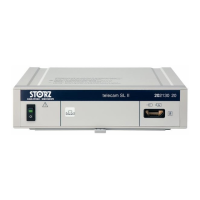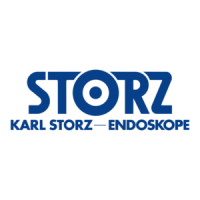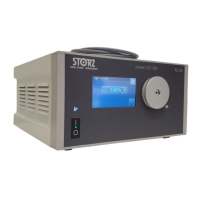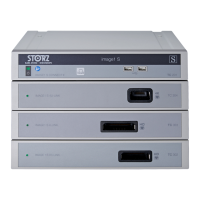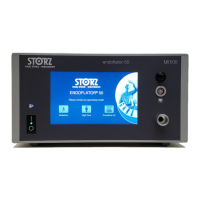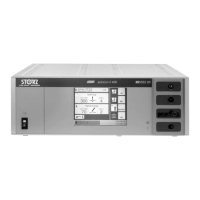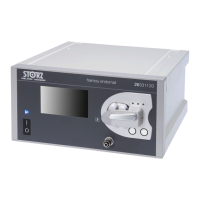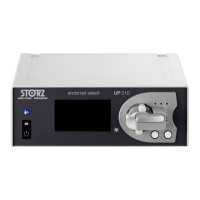Do you have a question about the Karl Storz TELE PACK + and is the answer not in the manual?
Emphasizes the importance of following instructions for safety and product integrity.
Stresses adherence to instructions for connected devices to prevent injury.
Specifies the product name and item number this manual covers.
Explains the meaning of various symbols and action indicators used in the document.
Details the different danger levels (WARNING, CAUTION, NOTICE) used in the manual.
Defines the product's purpose as a device for diagnostic/surgical procedures and stroboscopy.
Defines applicable diagnostic and therapeutic procedures requiring specific parameters.
Mentions no direct contraindications are known; physician decides based on patient condition.
Specifies that only qualified doctors and medical assistants may operate the device.
States there are no restrictions on patient groups for this product.
Defines what constitutes a 'serious incident' and notification requirements.
Warns about infection risk from using a non-cleaned product and mandates reprocessing.
Outlines requirements for qualified personnel and pre-use checks for functionality and damage.
Advises using only approved components and ensuring compliance with standards.
Warns about electric shock hazards from improper power supply and live parts.
Discusses potential impairment from external electromagnetic radiation and HF equipment.
Alerts to the risk of eye damage and tissue heating from high light output.
Warns about burns from hot components due to high light intensity.
States the product may fail during use and advises preparedness.
Emphasizes the risk of injury or damage if operated under unsuitable ambient conditions.
Warns about sparks igniting flammable gases/liquids and advises against use in flammable atmospheres.
Explains image failure due to contact with active electrode and metal parts during HF procedures.
Illustrates and labels the front and rear views of the TELE PACK + device.
Recommends checking product suitability for procedures and lists compatible camera heads.
Lists compatible camera heads for X-Line and C-Line connections with order numbers.
Lists compatible videoendoscopes for X-Line connection with order numbers.
Provides detailed specifications for power, display, memory, and interfaces.
Explains symbols found on product packaging, including manufacturer, date, and warnings.
Details symbols related to packaging, such as manufacturer, date, and handling.
Explains symbols found directly on the product, like usage instructions and CE marking.
Lists symbols found on the device's type plate, including manufacturer and disposal information.
Explains icons and symbols used within the product's user interface for various functions.
Specifies storage, transport, and operating temperature, humidity, and air pressure ranges.
Provides steps for carefully removing, checking, and handling the product packaging.
Details how to position the device, ensuring air circulation and safety precautions.
Guides on connecting the potential equalization cable, power cord, and network cable.
Explains how to connect peripheral devices like camera heads and microphones via USB.
Provides instructions and warnings for connecting the light cable safely.
Describes how to attach the camera head holder for storage and light cable mounting.
Outlines steps for performing a functional test to ensure the product operates correctly.
Details the procedure for powering the device on and off using the ON/OFF button.
Explains the function of the three buttons on compatible camera heads for menu control.
Lists required peripheral devices (keyboard, mouse) for operating the system.
Overview of the system's user interface elements and layout.
Explains how to configure the Quick Menu by moving, replacing, or adding functions.
Lists and describes how to connect various accessories like camera heads and footswitches.
Details connecting camera heads/videoendoscopes and changing button assignments.
Explains information retrievable via the footswitch.
Describes transferring recorded data to USB storage media.
Lists functions that can be configured if a printer is connected.
Provides a step-by-step guide for performing stroboscopy using the device.
Explains how to view recorded images and videos from the patient area.
Outlines options for protecting the product and menu access via password or user accounts.
Details how password protection secures certain menus.
Describes setting up user accounts with different access levels for enhanced security.
Explains the internal, USB, and network storage options for the product.
Discusses activating patient data management functions and privacy settings.
Details worklist setup, capture tools, and storage limits for patient data.
Specifies options for labeling digital recordings or prints with patient information.
Defines permitted data export formats, including USB and network transfer.
Explains operating the product in network mode for data storage on FTP or worklist servers.
Describes automatic data transfer to a server directory in FileShare mode.
Guides on configuring storage locations for FileShare and Worklist modes.
Explains selecting patients from a prepared list provided by a worklist server.
Details configuring worklist server settings, including IP address and port.
Describes accessing the network dialog to change settings and specify storage locations.
Explains network configuration via DHCP or manual entry on the LAN tab.
General maintenance policy stating activities must be by authorized personnel.
Recommends annual safety tests and checking configuration after software updates.
Mandates annual safety checks according to IEC 62353 for product and accessory integrity.
Details checking the product and accessories for mechanical damage and label readability.
Lists electrical measurements required for safety inspection, referencing IEC 62353.
Outlines performing a functional test and documenting safety inspection results.
States that repairs must be done by authorized personnel, except as described.
Explains proper disposal according to WEEE directive and national regulations.
Lists available accessories and spare parts for the product, noting regional availability.
Specifies suitable professional healthcare settings and industrial areas for product use.
Lists compatible accessories and cables for EMC compliance, with type, shield, length, and use.
Details immunity test levels and compliance for electrostatic discharge, transients, surges, and voltage variations.
Lists test levels for near fields from wireless communications equipment across various frequencies.
Provides test levels for radiated and conducted immunity, including separation distance calculations.
Classifies the product's RF emissions according to CISPR 11 and other emission standards.
Recommends minimum separation distances for HF devices to prevent electromagnetic interference.
Lists common symptoms, possible causes, and actions for resolving product errors.
| Category | Medical Equipment |
|---|---|
| Product Name | TELE PACK + |
| Manufacturer | Karl Storz |
| Application | Endoscopic Procedures |
| Type | Video Endoscopy System |
| Video Standard | HDMI |
| Integrated Components | Camera control unit, light source |
| Power Supply | 100-240 VAC, 50/60 Hz |
| Light Source | LED |
| Documentation | Image and video capture |
| Connectivity | USB, HDMI |
| Weight | Variable |
| Compatibility | Compatible with Karl Storz Endoscopes |
| Dimensions | Varies by configuration |
